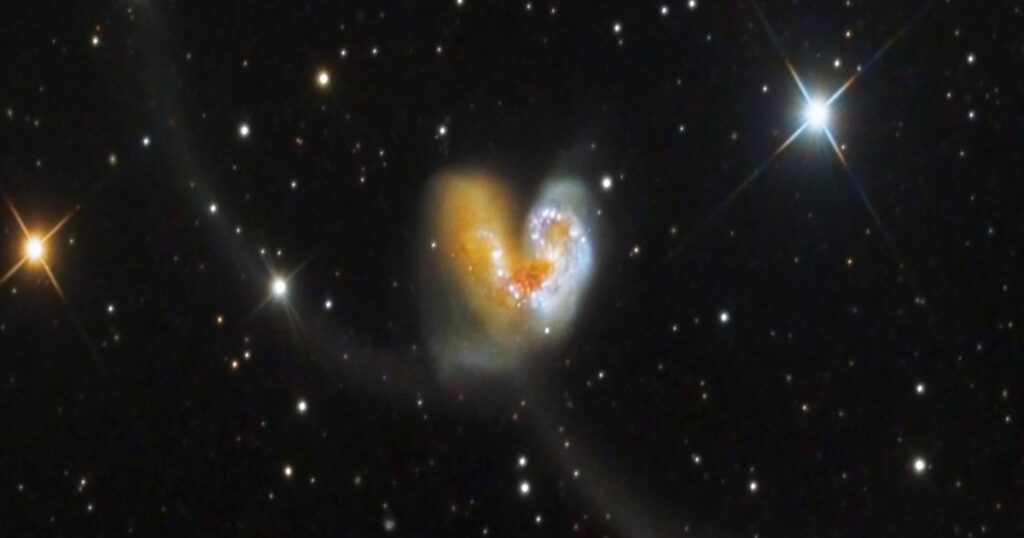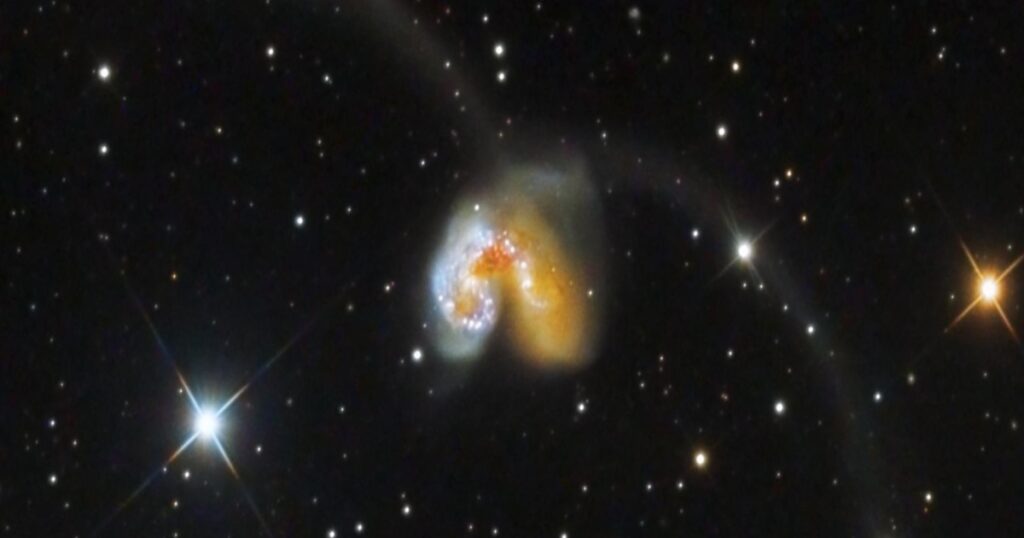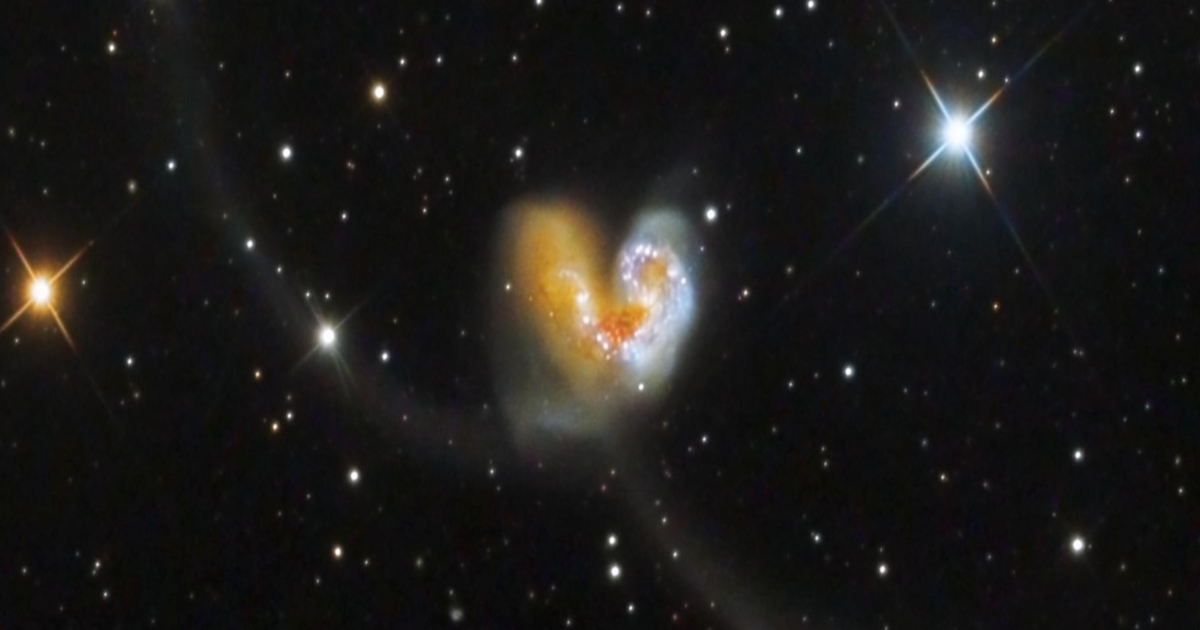NGC 4038 & NGC4039 are called the Antennae Galaxies (Colliding Galaxies) because these are the two galaxies in collision. Billions of stars will develop in the course of this merge. Super-star clusters are the densest and brightest of these star-forming areas.
The Antennae galaxies are among the closest and youngest instances of a pair of colliding galaxies since the two spiral galaxies just recently began to interact a few hundred million years ago. Tens of thousands of stars are seen in newborn clusters, which make up about half of the dim objects in the Antennae picture.

The two cores of the original galaxies are represented by the orange blobs to the left and right of the picture center. These blobs are mostly made up of ancient stars that are interspersed with brown-looking dust filaments. The two galaxies are shown in the photograph as pink spots with bright blue star-forming areas around incandescent hydrogen gas.
Astronomers can now more clearly discern between stars and mega-star clusters that are produced when two spiral galaxies collide thanks to the new image. Astronomers discover that only around 10% of the recently generated super-star clusters in the Antennae will last past the first 10 million years via age dating the clusters in the picture.
Most of the mega-star clusters that were created as a result of this interaction will break apart, and the individual stars will merge into the galaxy’s smooth backdrop.
Approximately one hundred of the largest clusters are anticipated to endure and develop into typical globular clusters, like the globular clusters present in the Milky Way galaxy. The lengthy, antenna-like “arms” that reach far from the centers of the two galaxies, which are best observed with ground-based telescopes, are the source of the Antennae galaxy names.
Between 200 and 300 million years ago, during the first meeting between the galaxies, these “tidal tails” were generated. They provide us a sneak peek at what may occur in several billion years when our Milky Way galaxy and the nearby Andromeda galaxy collide.

What is the Structure (Anatomy) of Antennae Galaxies (Colliding Galaxies)?
Prior to their collision, both NGC 4038 and NGC 4039 were classified as spiral galaxies. These majestic structures have beautiful, swirling arms packed with stars, gas, and dust. However, the gravitational tug-of-war during their encounter has significantly distorted their original forms.
The once-graceful arms have become elongated and warped, resembling the antennae of an insect, hence their captivating nickname. The collision has also triggered vigorous star formation in the compressed gas clouds, creating a chaotic yet visually stunning galactic landscape.
When and Who Discovered Antennae Galaxies (Colliding Galaxies)?
The first recorded observations of the Antennae Galaxies date back to the late 18th century. In 1784, the French astronomer Nicolas Louis de Lacaille documented them in his catalog of southern objects. However, it wasn’t until the 20th century, with the advent of powerful telescopes, that astronomers began to understand the true nature of this captivating galactic duo.
The dramatic transformation of the galaxies due to their collision became evident with detailed observations by telescopes like the Hubble Space Telescope. These observations revealed distorted structures, vigorous star formation, and long tidal tails, solidifying the “Antennae” nickname.
What is the Mass of Antennae Galaxies (Colliding Galaxies)?
While precise measurements are challenging due to the ongoing distortion, astronomers estimate the combined mass of the Antennae Galaxies to be somewhere between 4 to 7 times the mass of our Milky Way galaxy. This translates to a staggering amount of stars, gas, and dust swirling within their chaotic embrace.
What is the Size of Antennae Galaxies (Colliding Galaxies)?
The combined extent of the Antennae Galaxies is estimated to be roughly 130,000 light-years across. This vast expanse encompasses the distorted galactic disks, the long, trailing tails of gas and dust, and the vibrant regions of intense star formation.
What is Antennae Galaxies (Colliding Galaxies)’ Distance from Earth?
The Antennae Galaxies reside approximately 45 million light-years away from Earth in the constellation Corvus (the Crow). This vast distance translates to looking back in time, as the light we see from them has been traveling for 45 million years.
The Antennae Galaxies are not alone in their cosmic corner. They are part of a group of galaxies known as the Centaurus A/M Group, located near the Centaurus A galaxy. This group is a dynamic environment, with galaxies interacting and influencing each other through their gravity.

Future of Antennae Galaxies (Colliding Galaxies):
The collision of the Antennae Galaxies will continue for hundreds of millions of years more.
The gravitational pull will continue to distort their shapes, their swirling arms stretching further into the cosmos like celestial antennae, earning them their captivating nickname. Eventually, the galaxies will merge entirely, forming a single, elliptical galaxy, a testament to the violent ballet they once performed.
Importance of Antennae Galaxies (Colliding Galaxies):
The Antennae Galaxies are more than just a visually stunning celestial spectacle. Studying colliding galaxies like these provides valuable insights into several crucial astrophysical processes. Here are some key reasons why these galactic collisions are important:
Understanding Galaxy Formation and Evolution: Colliding galaxies offer a window into the past, allowing us to see how galaxies like our Milky Way may have formed through mergers over billions of years.
Probing the Mysteries of Supermassive Black Holes: At the center of most galaxies lies a supermassive black hole. When galaxies collide, these black holes may interact, potentially unleashing tremendous energy and providing clues about their behavior.
Insights into Star Formation: The compressed gas clouds caused by collisions trigger intense star formation, allowing astronomers to study the mechanisms that govern the birth of stars in extreme environments.
The Fate of our Milky Way: The Milky Way Galaxy is on a collision course with the Andromeda Galaxy in billions of years. Studying the Antennae Galaxies helps us anticipate the potential consequences of this future event.
What happens When Two or More Galaxies Collide?
When two or more galaxies collide, it’s not a quick smash-up. Instead, it’s a slow-motion ballet of destruction and creation lasting millions, even billions of years. The immense gravity of each galaxy tugs and pulls on the other, distorting their once-graceful spiral arms and triggering a chain reaction of events.
Gas clouds slam together, compressing them and igniting a frenzy of star formation. This period of intense birthing creates a dazzling display of young, hot stars.
Meanwhile, the gravitational turmoil can fling vast amounts of gas and dust outwards, forming long tails that stretch across the cosmos. Over time, the galaxies may lose some stars and gas that get flung out during the dance.
Eventually, after countless orbits and interactions, the galaxies will merge entirely, becoming a single, often elliptical-shaped galaxy, a testament to the dramatic encounter.
Antennae Galaxies as compared to Milky Way Galaxy:
Antennae Galaxies Vs. Milky Way Galaxy
| Feature | Antennae Galaxies | Milky Way Galaxy |
|---|---|---|
| Type | Colliding Spiral Galaxies (Merging) | Spiral Galaxy |
| Estimated Mass | 4-7 times Milky Way mass | Estimated mass of 200 to 400 billion times the Sun’s mass (including dark matter) |
| Estimated Size | 130,000 light-years across (combined) | 100,000 light-years across (diameter) |
| Distance from Earth | 45 million light-years | 0 light-years (We reside within it) |
| Location | Constellation Corvus (The Crow) | N/A (We are located within the Milky Way) |
| Discovery | 1784 by Nicolas Louis de Lacaille | Ancient observations |
| Current Status | Undergoing intense star formation due to collision | Ongoing star formation, but at a slower rate |
| Future | Likely to merge into a single elliptical galaxy | Likely to collide with Andromeda Galaxy in billions of years |
NGC 4038-4039 – Antennae Galaxies Collision as compared to Possible Milky Way Galaxy and Andromeda Galaxy Collision:
There is a possibility of collision between the Milky Way Galaxy and Andromeda Galaxy in around 4 to 7 billion years from now. We will see how that collision will be different from the collision of Antennae Galaxies:
Antennae Galaxies Collision Vs. Milky Way-Andromeda Collision
| Feature | Antennae Galaxies (NGC 4038-4039) | Milky Way-Andromeda Collision |
|---|---|---|
| Current Status | Undergoing head-on collision, galaxies merging | Separate spiral galaxies, slowly approaching |
| Timescale | Collision happening now, merger in hundreds of millions of years | Collision predicted in billions of years |
| Star Formation | Intense star formation due to compressed gas clouds | Ongoing star formation in both galaxies, but not at the extreme rate seen in Antennae |
| Outcome | Will form a single, massive elliptical galaxy | Likely to form a giant elliptical galaxy |
| Impact | Significant disruption within galaxies, potential ejection of stars and gas | Potential disruption within galaxies, ejection of stars and gas, possible impact on planetary systems |
Conclusion:
The Antennae Galaxies are a powerful reminder of the dynamic nature of the universe. Galaxies are not static islands but rather constantly evolving entities, locked in a cosmic ballet of creation and destruction. Studying these amazing collisions allows us to investigate the mysteries of stellar evolution, galaxy formation, and the grand dance that shapes the universe we inhabit.
